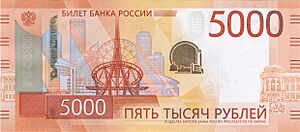Ruble facts for kids


The ruble (pronounced ROO-bl) is a type of currency used in several countries. Think of it like the dollar or the euro, but with a different name! Today, the most well-known rubles are the Russian ruble used in Russia and the Belarusian ruble used in Belarus.
Both of these rubles are divided into smaller units called kopeks. One ruble is equal to one hundred kopeks. Long ago, there were even smaller coins like the denga (half a kopek) and the polushka (a quarter of a kopek), but these are not used anymore. There is also the Transnistrian ruble, which is used in Transnistria, a region that is part of Moldova but acts like its own country.
The ruble has a very long history. At first, in ancient Russia, the word "ruble" was used to describe a certain weight of silver. Later, in 1704, a powerful ruler named Peter the Great made the ruble into a proper coin. It was special because it was one of the first currencies in the world to use a decimal system, meaning it was easily divided into 100 smaller parts (kopeks).
Over time, the ruble changed. After the Russian Empire, the Soviet ruble was used for many years, from 1922 until 1993. When the Soviet Union ended, many new countries were formed. They either started using their own new currencies or brought back the Russian ruble, like in the Russian Federation. Many other countries also used to have currencies called "ruble" because of their connections to Russia in the past.
Contents
What is the Ruble?
The ruble is the official money of Russia, where it's called the Russian ruble. It's also the official money of Belarus, known as the Belarusian ruble. Both of these currencies are divided into 100 kopeks. You'll see rubles as both paper banknotes and metal coins.
Countries Using the Ruble Today
Today, three main types of ruble currencies are used:
- Russian ruble: This is the official currency of Russia. It has been used since 1992. Some other regions, like Abkhazia and South Ossetia, also use the Russian ruble.
- Belarusian ruble: This is the official currency of Belarus. It has been in use since 1994, though its design has changed a few times over the years.
- Transnistrian ruble: This ruble is used in Transnistria. Transnistria is a region that declared itself independent, but most countries still see it as part of Moldova.
A Look Back: The Ruble's History
The ruble has a very long and interesting past. It was first used as a way to measure weight in Russia around the 1300s, even before it became a coin.
The Imperial Ruble
In 1704, during the time of the Russian Empire, Peter the Great introduced the imperial ruble. This was a big step because it was one of the first currencies in the world to use a decimal system. This meant one ruble was exactly 100 kopeks, making it easy to count and use. Different versions of the imperial ruble, like silver and gold rubles, were used for centuries.
The Soviet Ruble
After the Russian Empire, the Soviet Union was formed. In 1922, the Soviet ruble became the official currency. This ruble was used across all the countries that made up the Soviet Union for many years, until 1992.
New Countries, New Currencies
When the Soviet Union ended in 1991, many new independent countries were created. Each of these countries had to decide on its own money. Some, like Russia, continued to use a form of the ruble (the Russian ruble). Others, like Latvia and Tajikistan, briefly used their own versions of the ruble before switching to completely new currencies. This was an important time as countries established their own financial systems.
Images for kids
-
500 Belarusian rubles from 2009. This is the largest banknote used in Belarus today.
-
A five hundred ruble note from 1912. It shows Peter the Great and a symbol of Mother Russia.
-
The back of an 1898 Russian Empire one ruble note. It shows how much gold it was worth.
-
The front of an 1898 Russian Empire one ruble banknote.
See also
 In Spanish: Rublo para niños
In Spanish: Rublo para niños








